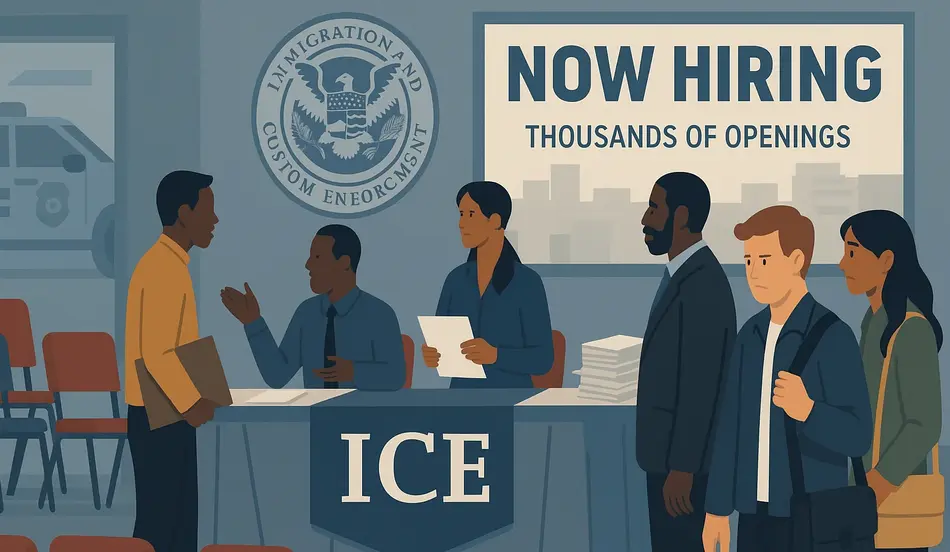ICE hiring jobs 2025 has become one of the boldest campaigns in U.S. federal law enforcement history. Immigration and Customs Enforcement, boosted by new Trump administration funding, is offering $50,000 signing bonuses, student loan forgiveness, and no age caps to attract tens of thousands of recruits.
Challenges in ICE Hiring Jobs 2025
But while the headlines promise opportunity, the reality is tougher. ICE hiring jobs 2025 come with serious challenges: overwhelmed training facilities, strict background checks, strained community trust, and growing concerns over oversight. The agency may be running an aggressive recruitment blitz, but for applicants, the path into ICE is far from simple.
A War Chest for Hiring
The Money Behind the Blitz
At the heart of ICE’s recruitment drive is a $30 billion hiring allocation, part of a broader $150 billion immigration enforcement package. This financial muscle allows the agency to offer unprecedented benefits in the world of federal recruitment.
These include:
- $50,000 signing bonuses (among the largest ever for federal agents).
- Student loan forgiveness, appealing especially to younger applicants and graduates carrying heavy debt.
- Expanded retirement benefits, attractive to older workers and military veterans.
- No age restrictions, opening the doors to a wider pool of recruits—from recent high school graduates to retirees.
The elimination of the age cap has been particularly transformative, drawing in applicants from demographics previously excluded. As one analyst noted, “ICE just broadened its funnel at both ends—young recruits seeking purpose and older candidates seeking stability.”

Applications Surge—But Only the Beginning
Since the campaign’s launch, ICE has received over 110,000 applications. The volume has stunned even seasoned federal recruiters, who are accustomed to struggling for talent in a competitive law enforcement market.
To date, ICE has extended more than 1,000 tentative job offers, including to former ICE employees brought back into service. Yet, with the ambitious target of 10,000 new hires, the gap between interest and actual onboarding remains wide.
Recruiters say many applications will fail at early stages due to background checks, psychological evaluations, and fitness requirements. Historically, only 7–10% of federal law enforcement applicants make it through to final hiring. If that ratio holds, ICE will need to process over 150,000 applications to reach its goal.
The Bottleneck: Training
FLETC at Breaking Point
The Federal Law Enforcement Training Centers (FLETC), the hub where most ICE officers train, is already near capacity. The facility cannot easily absorb thousands of extra trainees without sacrificing either space or instructional quality.
Plans are underway to establish satellite training sites in Texas, Florida, and Arizona, but those require infrastructure, staffing, and time. Even if successful, it may be 2026 or later before these new training centers can meaningfully contribute.
Experts warn of the dangers of rushing. After the rapid Border Patrol expansion following 9/11, reduced vetting and rushed training led to higher instances of misconduct and abuse. Critics argue ICE risks repeating those mistakes.
Deployment Challenges
Urban Hot Zones
The administration plans to assign many new ICE officers to Democratic-led cities such as New York, Chicago, and Los Angeles—areas where cooperation with local governments is limited and public resistance is strong.
This geographic mismatch creates two challenges:
- Community trust: Deploying large numbers of federal agents into hostile environments could fuel protests and weaken local law enforcement collaboration.
- Retention risk: Recruits placed in high-conflict zones may burn out quickly, undermining ICE’s hiring goals.
Local Police Strain
Some police departments worry about losing officers to ICE’s lucrative bonuses. Smaller agencies, already stretched thin, say they cannot compete with signing packages worth more than an officer’s yearly salary.
The Branding Push: Patriotism Meets Pop Culture
ICE’s recruitment blitz is not subtle. Its posters feature Uncle Sam pointing with the slogan: “America Needs YOU to Get Them Out.” Mobile billboards cruise city streets. Social media ads show officers in tactical gear set to cinematic music.
Adding to the spectacle are celebrity endorsements—most notably actor Dean Cain, who has promoted the campaign at rallies and media appearances. Videos highlight the mission-driven appeal of defending borders, while emphasizing financial security and benefits.
This heavy marketing has worked, drawing applications from people previously uninterested in law enforcement. But critics argue the campaign verges on propaganda, presenting enforcement roles in simplistic, heroic terms while downplaying the moral complexity and potential dangers.
Civil Rights Concerns
Civil liberties groups have raised alarms about the risks of such rapid expansion. They argue that ICE may be prioritizing speed over oversight, potentially hiring individuals with insufficient training in legal procedures, civil rights, or cultural sensitivity.
Organizations like the ACLU warn that “expanding enforcement power without adequate safeguards” risks civil rights violations, racial profiling, and erosion of trust with immigrant communities.
Employee Perspective: Why People Are Signing Up
For applicants, motivations vary widely:
- Financial incentives: Bonuses and loan forgiveness are a strong draw for debt-burdened Americans.
- Patriotism and service: Some view joining ICE as a way to defend the nation and contribute to security.
- Career stability: Federal jobs come with pension security, healthcare, and consistent pay—appealing in an uncertain economy.
Yet ICE’s polarizing reputation means that some applicants also face backlash. Reports have surfaced of new recruits losing friends or facing criticism online for “joining the deportation machine.”
Attract Motivated Professionals
Post your job on WhatJobs and connect with candidates driven by financial incentives, stability, and a commitment to service—even in a challenging labor market.
Post a Job Now →Looking Ahead: Can ICE Pull It Off?
The recruitment blitz has certainly achieved visibility, drawing massive interest in a short period. But whether it will translate into sustainable growth remains unclear.
Key hurdles include:
- Training bottlenecks that may delay onboarding by years.
- Attrition risks from hostile deployment zones.
- Public trust issues that could undermine ICE’s long-term legitimacy.
- Oversight gaps that might lead to misconduct and legal challenges.
If ICE succeeds, it could become the largest federal law enforcement body in the U.S., reshaping immigration enforcement for decades. If it fails, the campaign may be remembered as a costly experiment in flashy incentives without lasting results.
FAQ: ICE’s Hiring Blitz
Q1: Why is ICE offering such large incentives?
To meet ambitious hiring goals quickly under expanded enforcement mandates. Bonuses and benefits are designed to overcome deterrents tied to ICE’s controversial reputation.
Q2: What does removing age limits mean?
Anyone 18 and older can apply, including retirees and veterans. This vastly expands the potential talent pool.
Q3: Why can’t ICE just train more recruits faster?
Training requires specialized facilities and instructors. Current centers like FLETC are full, and rushing could compromise quality.
Q4: Are applicants motivated by money or mission?
Both. Some are drawn by student loan forgiveness and bonuses, others by patriotism or career stability..
Conclusion
ICE’s recruitment blitz is a striking example of how federal agencies can wield financial incentives and patriotic marketing to turbocharge hiring. It has succeeded in sparking nationwide interest, proving that even controversial agencies can attract applicants with the right mix of pay and promise.
Yet enthusiasm is only the first step. Training, oversight, deployment, and public trust will determine whether this surge translates into effective enforcement—or becomes another cautionary tale of rushed expansion.
For now, ICE stands at a crossroads: a powerful opportunity, shadowed by equally powerful risks.




